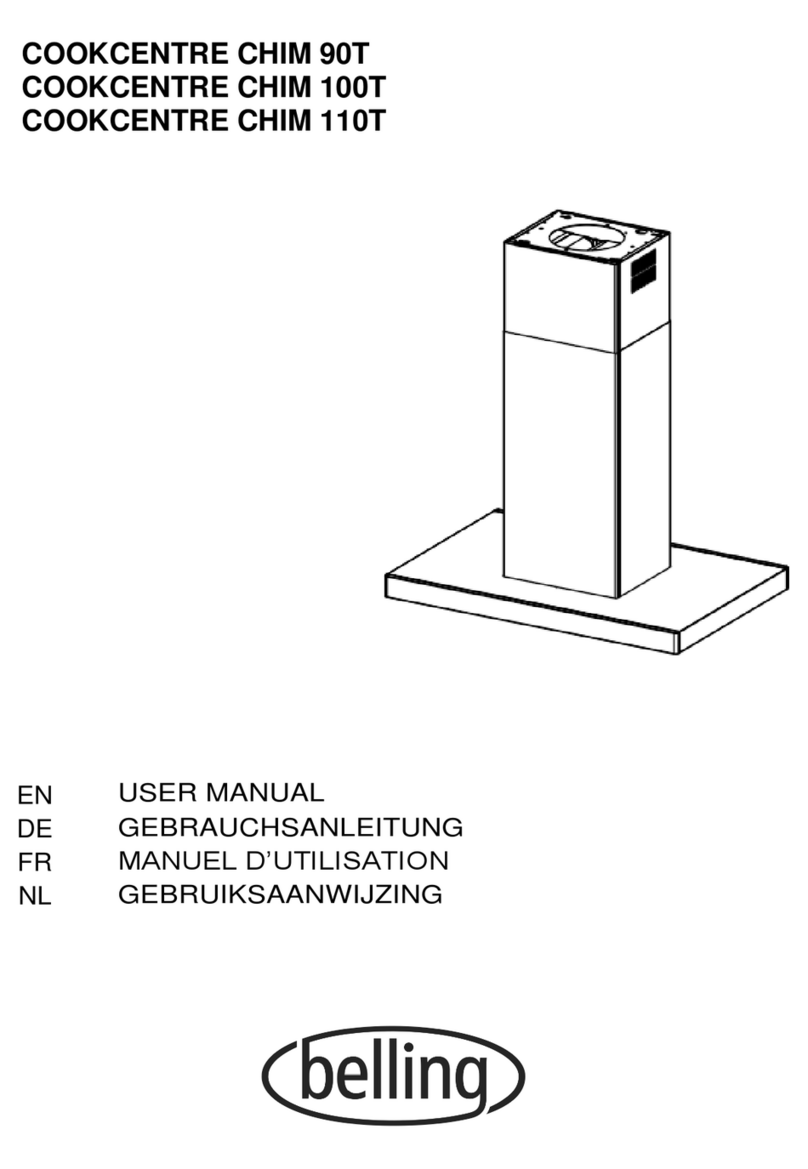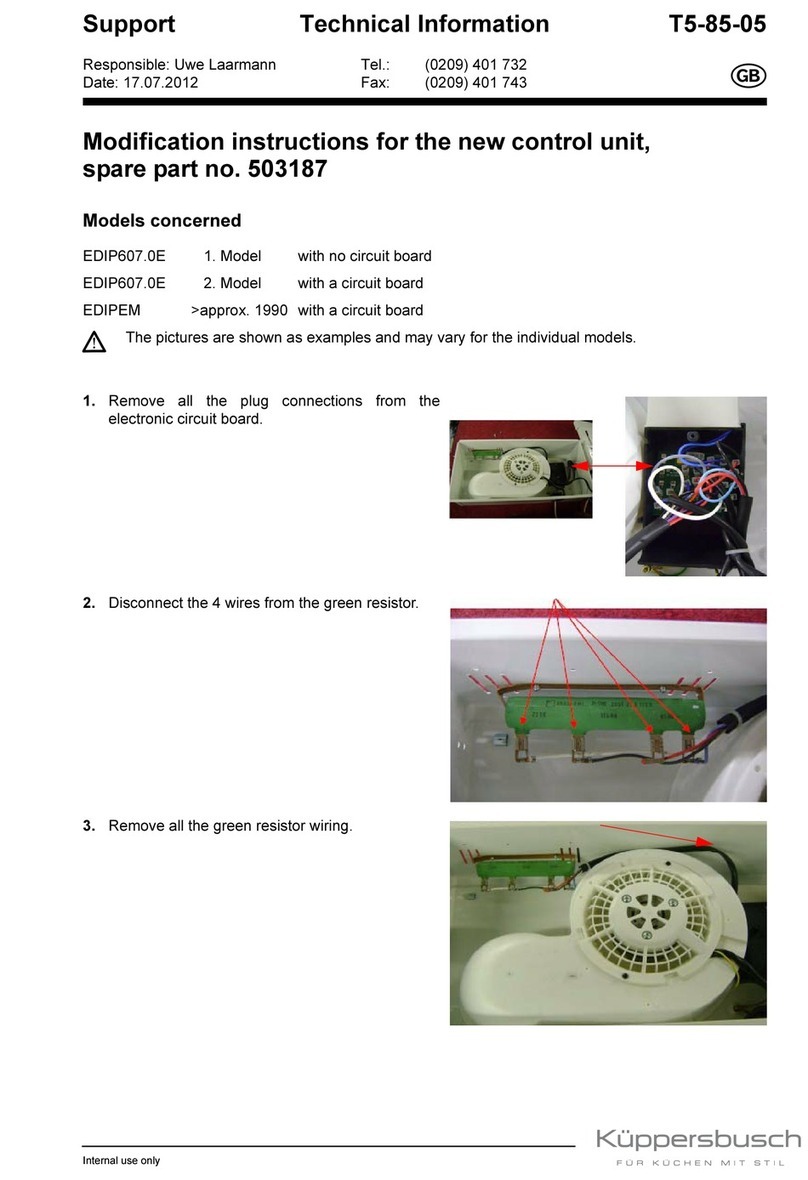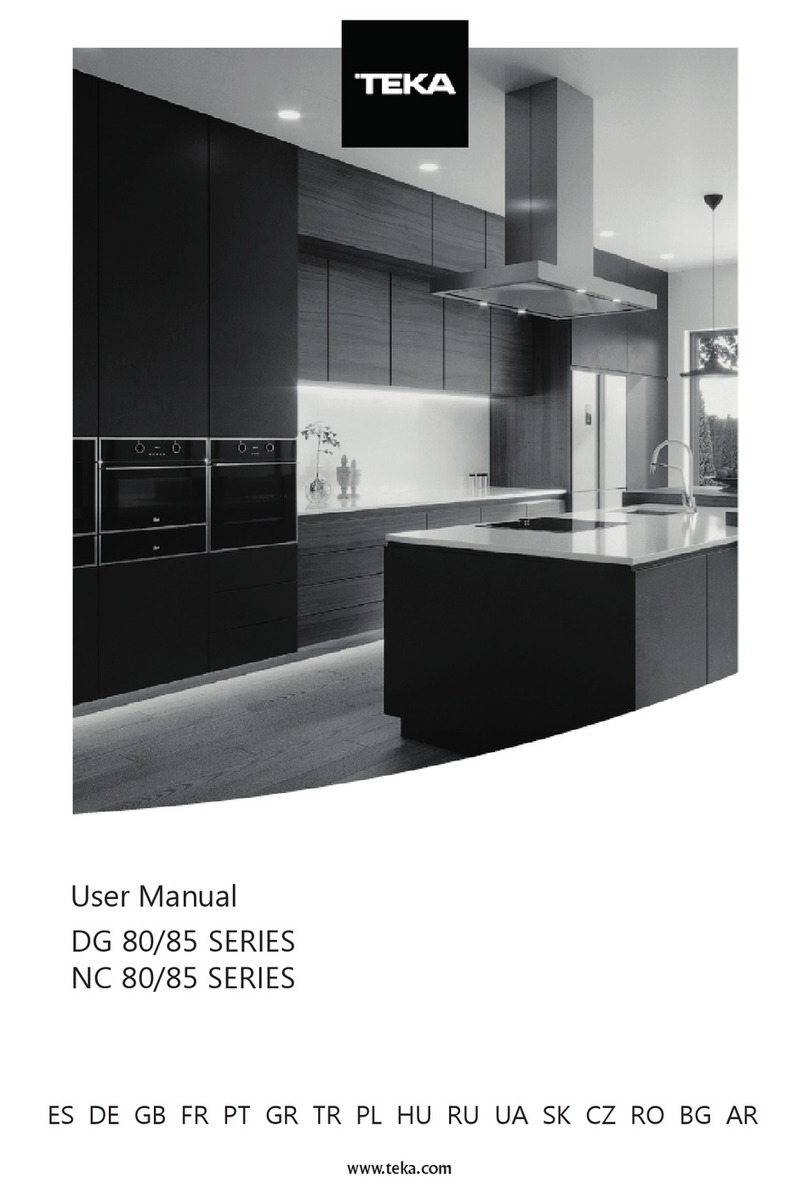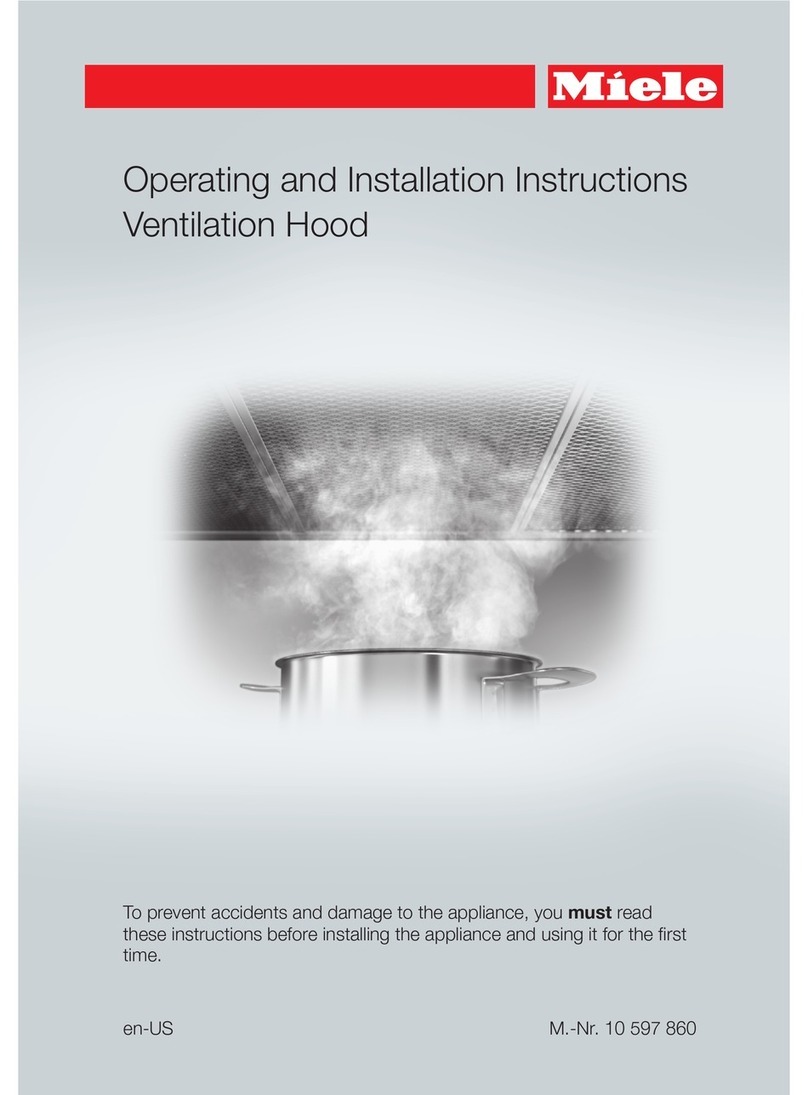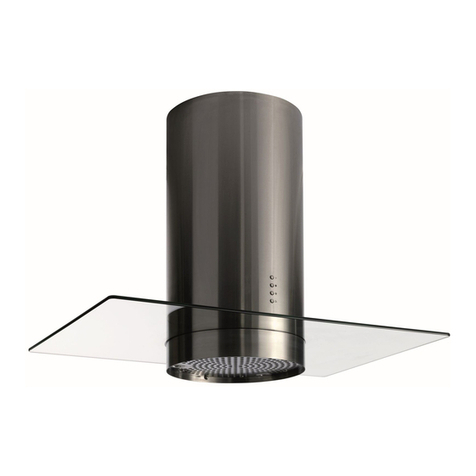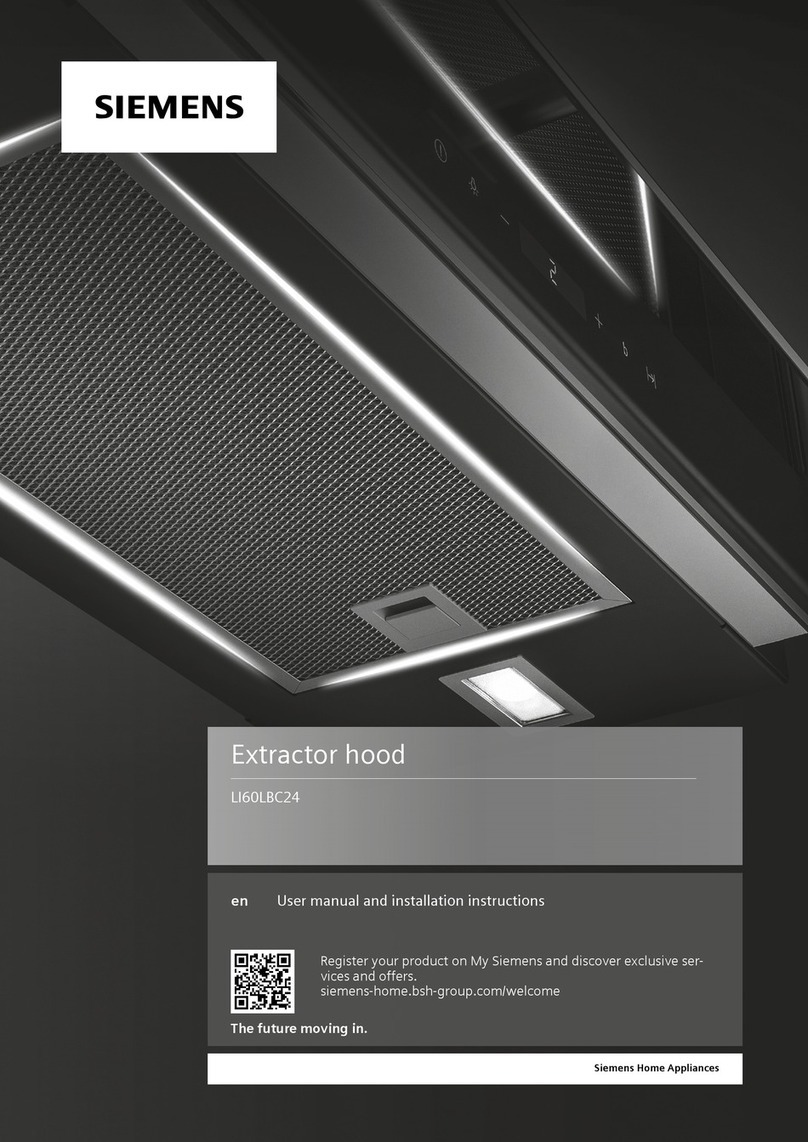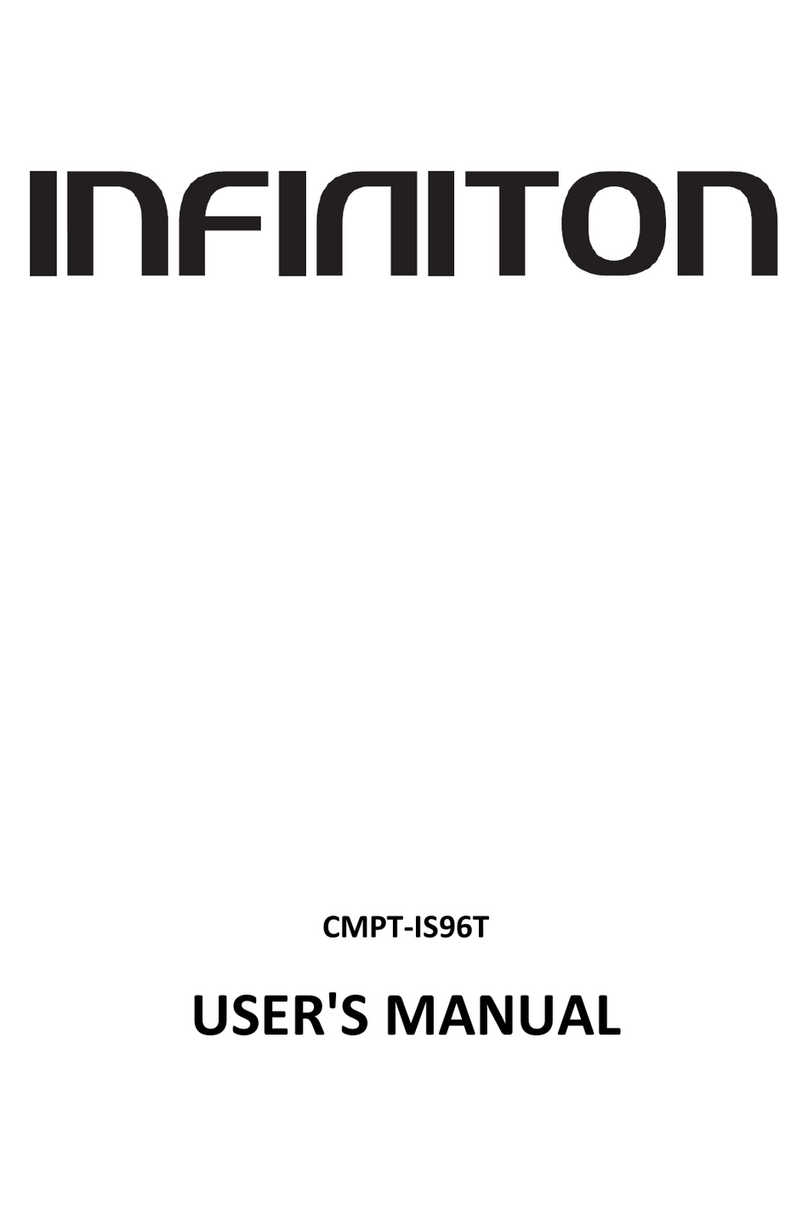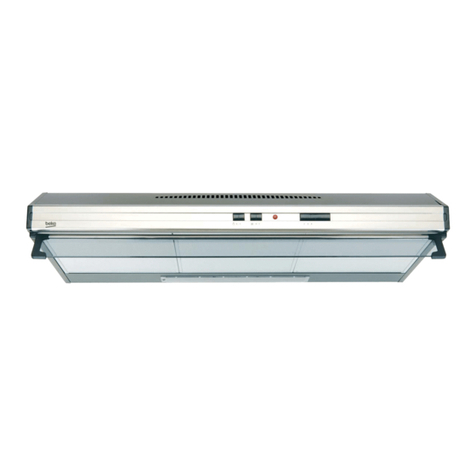mabe PVUS930 User manual

Models:
PVUS930
PVUS936
SERVICE Manual
RANGE HOOD CONTENTS
• Safety precautions
• Distance from the cooktop
• Technical specifications
• Technical data
• Parts supplied
• Non-return valve - parts supplied
• Aluminium panel / charcoal filter
• Installation
• Control drawing
• Touch control
• Bulbs
• Transformer
• Power board
• Electrical assembly
• Wiring diagram
• Motor
• Condenser
• Exploded view
• Spare parts list
• Troubleshooting
29-5829


- 3 -
SUMMARY
1. Safety precautions ........................................................................................................................4
2. Distance from the cooktop ............................................................................................................7
3. Technical specifications ................................................................................................................8
4. Technical data ...............................................................................................................................9
5. Parts supplied .............................................................................................................................10
6. Non-return valve (exhaust damper) - parts supplied...................................................................11
7. Aluminium panel / charcoal filter .................................................................................................12
7.1 replacing the aluminum panel
7.2 replacing the charcoal filter
8. Installation...................................................................................................................................13
8.1 prepare the appliance for mounting 8.1
8.2 mounting the hood in the lower part of the cabinet
8.3 mounting the hood on the wall
8.4 installing the charcoal filters and aluminum panels
9. Control drawing..........................................................................................................................19
9.1 configuration
9.2 technical drawing of control board
10. Touch control...............................................................................................................................21
10.1 replacing the touch control
11. Bulbs ...........................................................................................................................................23
11.1 replacing the halogen bulbs
11.2 replacing the halogen bulbs socket
12. Transformer.................................................................................................................................25
12.1 replacing the transformer
13. Power board................................................................................................................................26
13.1 replacing the power board
14. Electrical assembly .....................................................................................................................28
15. Wiring diagram............................................................................................................................29
16. Motor...........................................................................................................................................30
16.1 replacing the motor
17. Condenser ..................................................................................................................................34
17.1 replacing the condenser
18. Exploded view.............................................................................................................................35
19. Spare parts list............................................................................................................................36
20. Troubleshooting...........................................................................................................................37

- 4 -
Before connecting the model to the electricity
network:
- Check the data plate (positioned inside the
appliance) to ascertain that the voltage and power
correspond to the supply circuit. If in doubt ask a
qualified electrician.
- If the power supply cable is damaged, it must be
replaced with another cable or a special assembly,
which may be obtained direct from the manufacturer.
- This device must be connected to the supply
circuit through a hardwired spur protected by 3A
fuse.
WARNING !
In certain circumstances electrical appliances
may be a danger hazard.
A) Do not check the status of the filters while
the cooker hood is operating
B) Do not touch bulbs or adjacent areas, during
or straight after prolonged use of the lighting
installation
C) Flambè (Flamed) cooking is prohibited
underneath the cooker hood
D) Avoid free flame, as it is damaging for the
filters and a fire hazard
E) Constantly check food frying to avoid that
the overheated oil may become a fire hazard
F) Disconnect the electrical plug prior to any
maintenance
G) This appliance is not intended for use by
young children or infirm persons without
supervision
H) Young children should be supervised to
ensure they do not play with the appliance
I) There shall be adequate ventilation of the
room when the rangehood is used at the same
time as appliances burning gas or other fuels
L)There is a risk of fire if cleaning is not carried
out in accordance with the instructions
M) Please use a dedicated plug receptacle for
power plug
N) Please don’t operate the hood when there is
a flame on the dishes or frying pan
O) Please don’t touch the product or operate
the switch with wet hands
P) Please don’t wipe off the hood with the
chemicals when cleaning.
The symbol on the product or on the accom-
panying paperwork indicates that the appliance
should not be treated as domestic waste, but
should be delivered to a suitable electric and
electronic appliance recycling collection point.
Follow local guidelines when disposing of waste.
For more information on the treatment, re-use and
recycling of this product, please contact your local
authority, domestic waste collection service or the
shop where the appliance was purchased.
Assembly and electrical connections must be
carried out by specialised personnel.
• Electric Connection
The connection to the mains is carried out as
follows:
BLACK = L line
WHITE = N neutral
GREEN/YELLOW = G ground
Connect to a junction box suitable for the electrical
load indicated on the description label.
An omnipolar switch with a minimum opening of
3mm between contacts, in line with the electrical
load and local standards, must be placed between
the appliance and the network in the case of direct
connection to the electrical network.
Before proceeding with the assembly operations,
remove the anti-grease filter(s) so that the unit is
easier to handle.
In the case of assembly of the appliance in the
venting version prepare the hole for evacuation of
the air.
• We recommend the use of an air exhaust tube
which has the same diameter as the air exhaust
outlet hole. If a pipe with a smaller diameter is
used, the efficiency of the product may be reduced
and its operation may become noisier.
Safety precautions

- 5 -
Safety precautions
• We recommend that the cooker hood is switched
on before any food is cooked.We also recommend
that the appliance is left running for 15 minutes
after the food is cooked, in order to thoroughly
eliminate all contaminated air.
The effective performance of the cooker hood
depends on constant maintenance; the anti-
grease filter and the active carbon filter both
require special attention.
• The anti-grease filter is used to trap any grease
particles suspended in the air, therefore is subject
to saturation (the time it takes for the filter to
become saturated depends on the way in which
the appliance is used).
- To prevent potential fire hazards, the anti-grease
filters should be washed a minimum of every
2 months (it is possible to use the dishwasher for
this task).
- After a few washes, the colour of the filters may
change. This does not mean they have to be
replaced.
If the replacement and washing instructions are
not followed, the anti-grease filters may present a
fire hazard.
• The acrylic filter, which is found resting on the
grille, should be replaced when the text, visible
through the grille, changes colour and the ink
spreads; the new filter should be fitted in such a
way that the text can be seen through the grille
from outside the cooker hood.
• If the filters do not have any text on them, or if
metal filters or aluminium panel filters are used,
they should be washed every 2 months in order to
prevent the risk of fire.
To wash the filters, proceed as follows:
- Remove the filter from the grille and wash it using
a solution of water and neutral liquid detergent,
leaving the dirt to soften.
- Rinse thoroughly with warm water and leave to
dry.
• The active carbon filters are used to purify the
air which is released back into the room. The
filters are not washable or re-usable and must
be replaced at least once every four months. The
active carbon filter saturation level depends on the
frequency with which the appliance is used, the
type of cooking performed and the regularity with
which the anti-grease filters are cleaned.
• Remove build-up from the fan and other surfaces
of the cooker hood regularly using a cloth moistened
with denatured alcohol or non-abrasive neutral liquid
detergent.
CAUTION!
Wear gloves during the installation of the product
otherwise injury at ngers could happen by sharp
edges.

- 6 -
Safety precautions
WARNING !
• Take care when the cooker hood is operating simultaneously with an open fireplace or burner that
depend on the air in the environment and are supplied by other than electrical energy, as the cooker
hood removes the air from the environment which a burner or fireplace need for combustion. The
negative pressure in the environment must not exceed 4Pa (0.016 WC.). Provide adequate ventilation
in the environment for a safe operation of the cooker hood. Follow the local laws applicable for external
air evacuation.

- 7 -
Distance from the cooktop
• The minimum distance between the support surfaces of the cooking pots on the cooker top and the lowest
part of the cooker hood must be at least 30’’.
If a venting tube composed of two parts is used, the upper part must be placed outside the lower part.
Do not connect the cooker hood exhaust to the same conductor used to circulate hot air or for evacuating
fumes from other appliances generated by other than an electrical source.
30”
min.

- 8 -
Technical specifications
CONTROLS
ALUMINIUM PANELS LIGHT
MODELS PVUS930
PVUS936
Size 30’’- 36’’
Finish St.steel
Motor HB4
Extracting power (CFM) 600
Voltage 110-120V ~ 60Hz
Motor power consumption 1 x 420 W
Product certification UL
Product class Class I
Type model PVUS930S1SV -
PVUS936S1SV
Air outlet diameter (mm) 150
Controls Touch Control
Speeds 3+1
Version Duct out
Filters Aluminium panels
Charcoal Filters 2 Circular filters
Bulbs 2 x 20 W Halogen lamps
Weight Gross 22,7 - 23,9 Kg

- 9 -
Technical data
22''
29-15/16'' - 35-15/16''
11'' 1
-3/8
''
10''
1-13/16''
3
''
12''
3-1/4''

- 10 -
Parts supplied
NON RETURN VALVE
(exhaust damper)
2 CHARCOAL FILTERS
(air recirculation option only)

- 11 -
Non-return valve
parts supplied
The non-return valve (exhaust damper) is
recommended when the appliance is installed in
the extracting version, to prevent cold air blowing
back in from outside.
The valve is made up of two parts which must be
fixed to the air outlet flange on the motor assembly
If the appliance is installed in the recirculation filtering
version, the non-return valve is not necessary.

- 12 -
Aluminium panel
Charcoal filter
The metal filters and/or aluminium panel are also dishwasher
safe.If the filters are made using aluminium, or if an aluminium
panel is used, after a few washes the colour may change.
This does not mean they have to be replaced.
If the replacement and washing instructions are not followed,
the anti-grease filters may present a fire hazard.
To replace the aluminium panels, simply operate the handle
(a) provided for the purpose, as illustrated in the drawing.
The active carbon filters are used to purify the air which is
released back into the room. The filters are not washable
or re-usable and must be replaced at least once every four
months. The active carbon filter saturation level depends on
the frequency with which the appliance is used, the type of
cooking performed and the regularity with which the anti-
grease filters are cleaned.
To replace the active charcoal filters, simply operate the
handle provided for the purpose, as illustrated in the drawing.
Replacing the aluminium panel (a) 7.1
Replacing the charcoal filter (b) 7.2 (on some models)
a
b

- 13 -
Installation
Prepare the appliance for mounting 8.1
WARNING
Before beginning the installation, switch power off at service panel and lock the service disconnecting
means to prevent power from being switched on accidentally. When the service
disconnecting means cannot be locked, securely fasten
a prominent warning device, such as a tag, to the
service panel.
WARNING – TO REDUCE THE RISK OF FIRE, ELECTRIC SHOCK, OR INJURY TO PERSONS,
OBSERVE THE FOLLOWING:
A. Installation work and electrical wiring must be done by qualified person(s) in accordance
with all applicable codes and standards, including fire-rated construction.
B. Sufficient air is needed for proper combustion and exhausting of gases through the flue
(chimney) of fuel burning equipment to prevent back drafting. Follow the heating equipment
manufacturer’s guideline and safety standards such as those published by the National Fire
Protection Association (NFPA), and the American Society for Heating, Refrigeration and Air
Conditioning Engineers (ASHRAE), and the local code authorities.
C. When cutting or drilling into wall or ceiling, do not damage electrical wiring and other hidden
utilities.
D. Ducted fans must always be vented to the outdoors.
E. This unit must be grounded.
WARNING - TO REDUCE THE RISK OF FIRE, USE ONLY METAL DUCTWORK.
CAUTION!
Wear gloves during the installation of the product otherwise injury at ngers could happen by sharp edges.

- 14 -
Installation
Phase 1
Phase 2
Phase 1
- Before carrying out assembly operations, open the packaging,
take the hood and place it on a comfortable surface.
- Remove the anti-grease filter/s as shown in the picture.
Phase 2
- If hood installation is used with the air outlet Fig.1B or
Fig.4B, the wires set-up in the relevant wiring harness must
be released by pulling the lever outwards, as indicated in
figure 2, phase 1-2.
- Disconnect the 6-way quick coupling of the motor located
inside of the hood, as show in figure 2. - phase 3.
- The wires positioned inside of the hood are fasted with a
cable tie. Cut the cable tie as shown in figure 2 - phase 4.
Once transformation operations have been completed,
reassemble the components following
the steps in reverse (Fig.2).
In this way it will be easier to manoeuvre the unit.
- If the appliance is to be mounted in DUCTING version,
prepare the air evacuation hole.
- It is recommended to use an air evacuation pipe with the
same diameter as the air outlet
flange. The use of a reduction could decrease product
performance and increase noise.
fig.1B
fig.4B fig.2

- 15 -
Installation
Phase 4
Phase 3
- Attention!
This product utilizes the air evacuation hole available in 2 dierent
positions, which can be used according to your requirements;
1 – In the upper part of the hood Fig.1A.
2 – In the rear part of the hood Fig.1B.
- The air evacuation ange is supplied with the rectangular shape
X and circular shape Y (Fig.1).
Phase 4
- Version with air evacuation hole in the upper part of the
hood (Fig.3):
This product is supplied with the air outlet in the upper part
and the electric connection box positioned in the rear part of
the hood.
- If a rectangular air outlet pipe is used E, the hood is already
set-up (Fig.3.A).
- If, however, a circular air outlet pipe is to be used F, the 7
screws H must be removed along with the bracket X (Fig.3.B).
Phase 5
- Version with air evacuation hole in the rear part of the hood
(Fig.4):
If your requirements are the use of the air outlet in the rear
part of the hood (carry out all phases shown in figure 2),
remove the screws I (Fig. 4.A) that fix the motor bracket Y
and turn the entire motor unit and position it as indicated in
Fig.4.B. Put the motor bracket Y back in its seat and fix it with
the previously removed screws I.
Attention!
Whenever a circular air outlet pipe is to be used F, the
operation indicated in Fig.3.B must always be repeated.
Phase 3
fig.1
fig.3
Phase 5
fig.4

- 16 -
Phase 1
- Check that the screws used that are not supplied with the
product are suitable for the type of object.
- Position the fixing template surface B on the lower part of
the shelf (Fig.8), (considering the minimum distance from the
cooker top).
- Make 6 holes in the cabinet shelf respecting the measurements
indicated (Fig.7).
- Fix the 4 screws A (Fig.9B) without tightening them completely.
- Position the hood under the cabinet, push towards the wall so
the screw heads fully engage in the slots, tighten/fasten the 4
screws A and fix it definitively using the 2 safety screws B.
Installation
Phase 1
Mounting the hood in the lower part of the cabinet 8.2
This product can be installed in 2 different ways:
fig.9B
fig.8
fig.7

- 17 -
Phase 1
- Position the fixing template surface A on the wall (Fig.8),
(considering the minimum distance from the cooker top).
- Make 4 holes respecting the measurement indicated in the
figures (Fig.7).
- Fix the 2 upper screws A (fig.9A) without tightening them
completely along with the plugs.
- Hang the hood on the wall, aligning it in a horizontal position
and tighten/fasten the 2 screws A. When it has been adjusted,
fix it definitively using the 2 safety screws B.
For the various installations use screws and screw anchors
suited to the type of wall (e.g.reinforced concrete, plasterboard,
etc.). If the screws and screw anchors are provided with the
product, check that they are suitable for the type of wall on
which the hood is to be fixed.
Installation
Phase 1
Mounting the hood on the wall 8.3
fig.9A
fig.8
fig.7

- 18 -
Installation
Installing the charcoal filters and aluminum panels 8.4
Phase 1
Phase 2
Phase 1
- Take the active charcoal filters and position them in their
housings.
Phase 2
- Take the aluminum panels and position them in their
housings.

- 19 -
Control drawing
Configuration 9.1
Push-button A = On/off lights switch.
Push-button B = On/off cooker hood switch. The appliance switches on at speed level 1, If the cooker
hood is on depress the push-button for 2 sec. to switch off the cooker hood. If the cooker hood is
at speed level 1 it will not be necessary to depress the push-button to switch the cooker hood off.
Decreases the motor speed.
Display C = Indicates the motor speed level selected and activates the timer.
Push-button D = Switches on the cooker hood. Increases the motor speed. Touching the key at 3rd
speed, the intensive function runs for 10 minutes, then the appliance go back to work at the original
speed. During this function the display blinks.
Key E = The Timer times the functions on activation for 15 minutes, after which they are switched off.
The Timer is deactivated by re-pressing Key E. When the Timer is activated the decimal point must
flash on the display. The Timer cannot be activated if the intensive speed is functioning.
- The “clean air” function is activated by pressing key E for 2 seconds when the appliance is switched
off. This switches the motor on for 10 minutes every hour at the first speed.
During functioning a rotary movement of the peripheral segments must be visualised on the display.
When this time has passed the motor switches off and the fixed letter “C” must be visualised on the
display until the motor re-starts after 50 minutes for another 10 minutes and so on. Press any key apart
from the light keys to return to normal functioning. Press key E to deactivate the function.
• Active carbon/grease filter saturation:
- When display item C flashes, at a speed where it alternates with the letter F (e.g. 1 and F), the grease
filters must be washed.
- When display item C flashes, at a speed where it alternates with the letter A (e.g. 1 and A), the carbon
filters must be replaced.
After the clean filter has been positioned correctly, the electronic memory must be reset by pressing
button A for approximately 5 seconds, until the indication F or A shown on the display C stops flashing.

- 20 -
Control drawing
Technical drawing of control board 9.2
This manual suits for next models
1
Table of contents
Other mabe Ventilation Hood manuals



